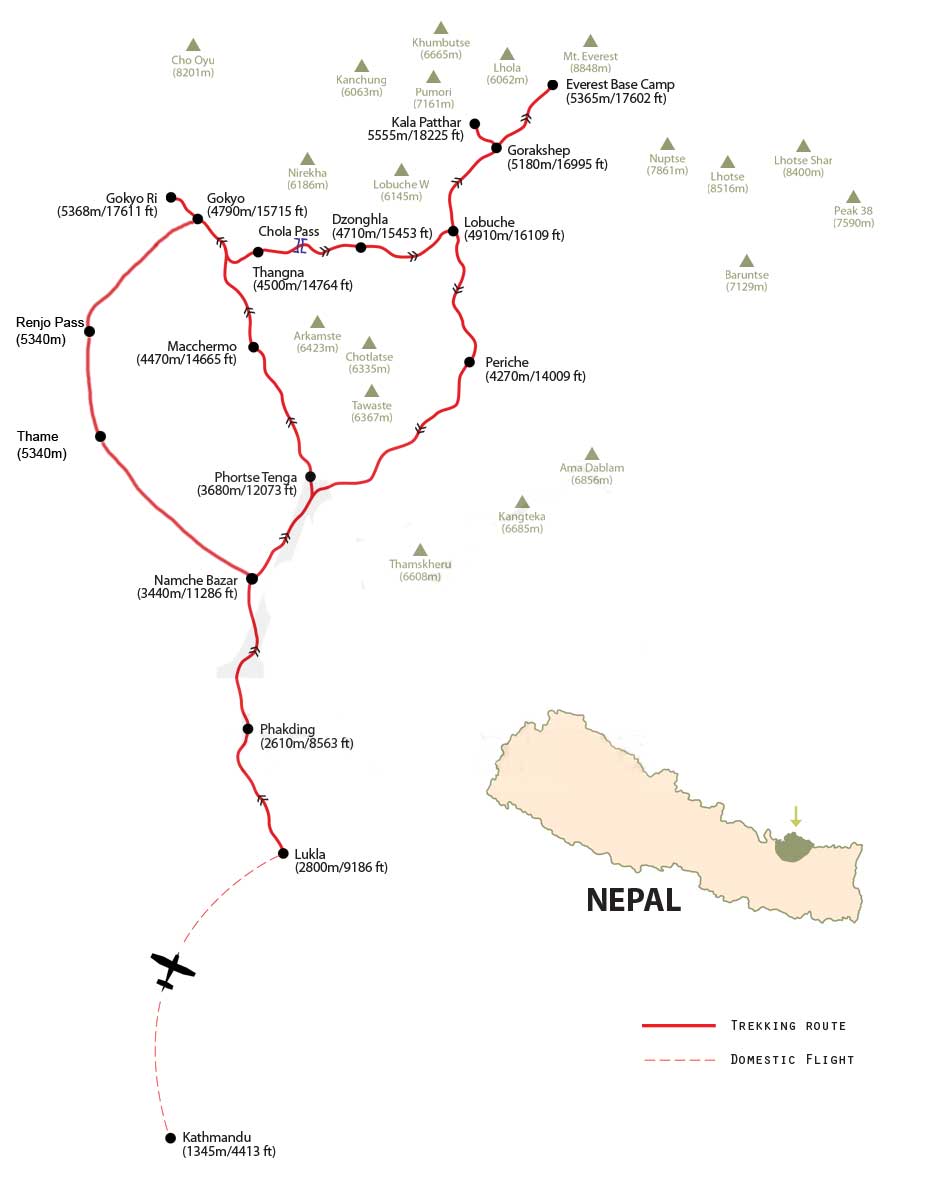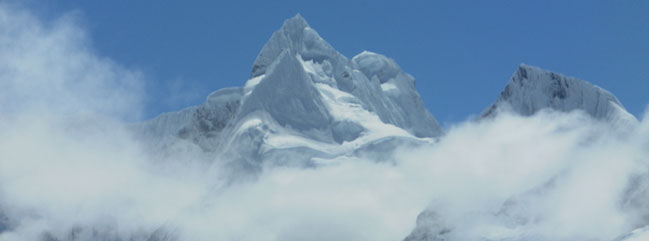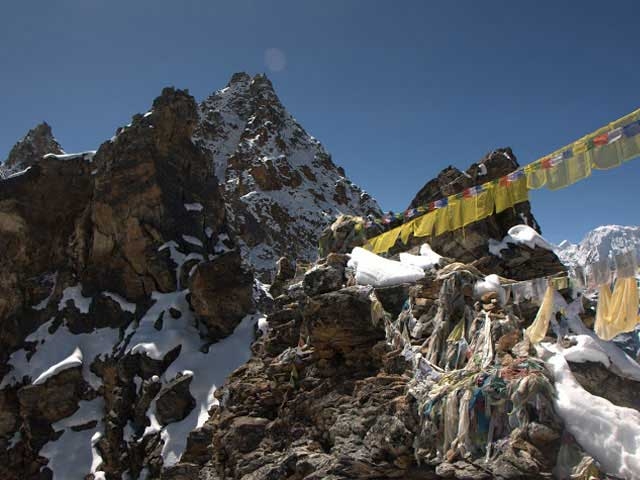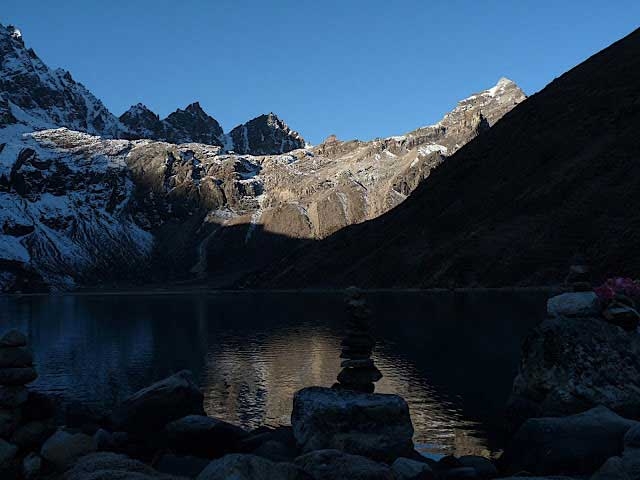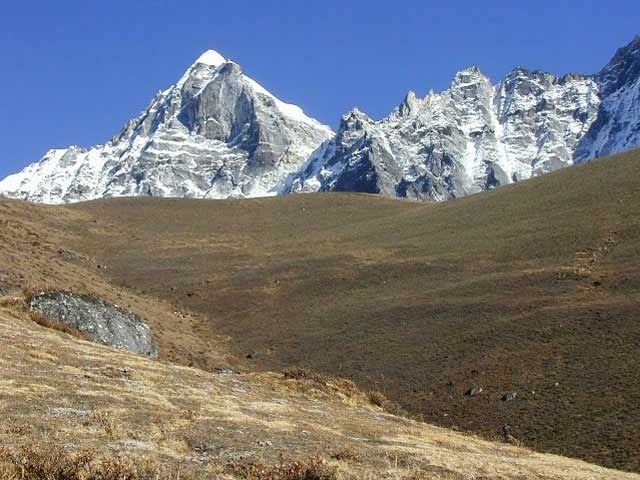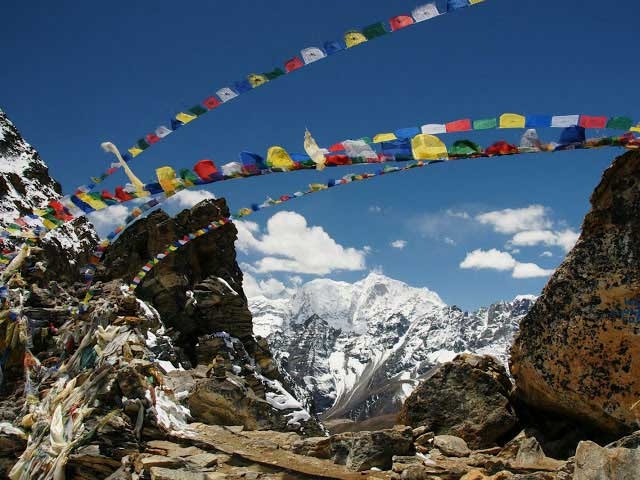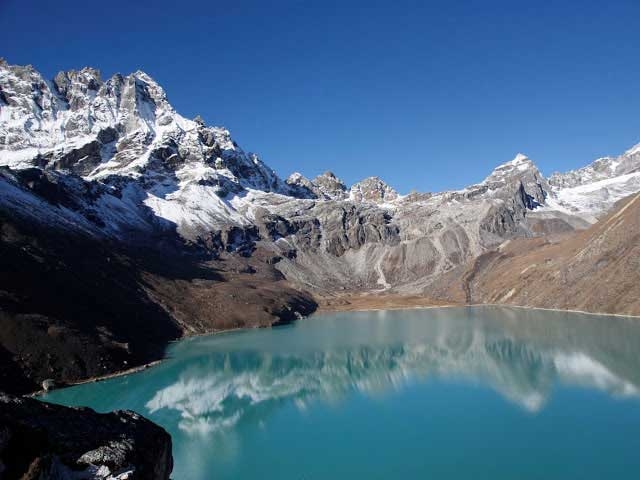Renjo la pass trek is less crowded trekking trail of Everest region. Renjo la pass trekking offers life time experience. Gokyo valley renjo la pass trek can continue either from Thame village to Gokyo valley or Gokyo valley to Thame village. Renjo pass trek is no doubt one of the most thrilling trekking in Everest trekking region. Renjo La pass trek offers an panoramic Himalayan views of Mahalangur Himalayan range, including of Mt. Everest (8848m), Mt. Lhotse (5816m), Mt. Maklau (8463m), Mt. Cho Oyu (8201m) , Nuptse (7855m), Mt. Ama Dablam (6856m), Mt. Thamserku (6723m) etc. Renjo la pass trek is combined treks of Gokyo valley and Nangpala valley. Renjo La pass (5,446m) trekking is the most stunning trips of Himalayas.
Gokyo- Rejo La pass trek is considered as classic and suitable for average people. So if you are moderately fit and have a sense of adventure you will enjoy Renjo la pass trek. Trekking program is designed to acclimatize you gradually not to be high altitude sickness. However you are requested to check your altitude fitness and itinerary. Everest Rinjo La pass trek is one of the best trekking routes for anyone. Renjo la pass trek leads the high pass Renjo La which on the way to Tibet Boarder Nag pa-la and Gokyo valley. Renjo la pass trek is ideal for those people who like to do trek go through high pass but not difficult one.
Renjo La pass trek offers an alternative route for the travelers who are searching for natural beauty and mountains scenery. Mt. Everest, Mt. Makalu and Mt. Cho Oyo are highlights of Gokyo valley-Renjo La pass trek. Renjo la pass trek make the Gokyo trek circuit. Renjo la pass is a popular adventure trek in the Everest region. Renjo Pass route is off the usual beaten track. At the pass, a great view of the Gokyo lakes on one side, the Rermo Pokhari lakes on the other side, and surrounded by snowy peaks provides this incredible atmosphere. It takes us to the Gokyo and Nangpa valleys through beautiful Sherpa villages Thame.
Gokyo trek to renjo la pass is newly open high pass trekking of Everest region. Gokyo, Renjo la pass trek is going popular between trekkers. Renjo la pass trekking is tea house trek, Alternatively we organize full board camping treks also on request. Best season for Renjo la pass trekking is September to December, and February to May. Renjo la pass trek is moderate trekking trail of Everest region. Renjo la pass (5345) is the highest access of Renjo la pass trek. Renjo la pass trek highlight and Renjo la pass trekking route maps given in side bar. Renjo la pass trek itinerary can customize according to guest holiday schedule also. Base camp trekking arranges Private Renjo la pass trek any time in season. If you need more information about Renjo la pass trek fell free to contact us.
Day 01: Arrive at Kathmandu Upon arrival at international airport meet assist and transfer to the Hotel (star category, very nice and centrally located at Thamel), take rest and free at afternoon.
Day 02: Kathmandu Valley Sightseeing pre- Treks (1350m) Our Tour Guide led you explore around Kathmandu valley for the sight seen. Have explore historical and spiritual attractions; including the historic Kathmandu Durbar Square; the House of Living Goddess “Kumari” and Kasthamandup temple” Said that was built from single tree in 16th century, Big bell-Big drams, Erotic carving in old temple, old palace etc., Bouddhanath; one of the largest Stupas in Nepal, Swayambhunath; situated on top of the hill knows as the Monkey Temple is one of the oldest Buddhist Stupa in the world, which has been registered in UNESCO heritage side. Pasupatinath; Hindus holy place, Sadhus and pilgrims bathing at occasionally, funeral pyres burning on the Ghats, located on the holy Bagmati river. Finally we have sightseeing beautiful Patan Durbar squares; the Krisna Temple has build just by stone with incredible crafts, Patan king’s palace, Golden temple and much more. It is very famous for woodcarving, Metal works, Temples and Monasteries. If we have time there are still more remark site; the one of the oldest cities in Kathmandu valley “Bhaktapur” is known as Living Museum. Where, old brick paved enclave of old Royal palace, Nyathapola Temple, Datatriya temple exquisite artwork offers a picture of the grandeur of medieval Nepal. After these activates back to hotel and pre- prier for the treks. Stay overnight at hotel. Please, check your insurance details and have a copy of your travel medical insurance policy with you.Day 03: Fly from Kathmandu to Lukla (2,800m) -30 munities, trek to Phakding (2,640m) -3 to 4 hours Early in the morning fly Kathmandu to Lukla (30 to 40 min) then final preparations for the trekking. From Lukla you’ll pass Chaurikharka village and make a descent towards the Ghat (2,530m). The trail follows the bank of the Dudhkosi River. To assist acclimatization, this first day Treks is 3 to 4 hrs short distance. But if people are still interested to do more activities they will have an opportunity to do the side trip to monastery around in Phakding. And overnight at Lodge.
Day 04: Phakding to Namche Bazaar (3,430m) -5 to 6 hours The trail follows the Dodh Kosi River banks and reaches in Tok Tok. You can see excellent views of Thamserku peak from here. Then trail climbs to Chomoa, site of an agricultural project farm, still trail climbs to Monju (2,840m) and enters the Sagarmatha National Park Area (1,148 sq km, established in 1976). Walking some distance up you will be at Jorsale (2830m) and after cross last (fifth number) bridge the trail again long climb on where you have the view of Mt. Everest, over the right Nupste (7,879m). After 5 to 6 hrs walking the trail reaches the street of Namche Bazaar at last. Stay overnight in Namche Bazaar overseers’ snow capped Mountains and Sherpa heritage.
Day 05: Acclimatization in Namche Bazaar and visit Khumjung Village (3,790m) After having late breakfast walk for the sightseeing around Namche Bazaar then hike to the Everest View Hotel. The ideal place to overview some of the outstanding mountains such as Mt.Everest, Nupste, Ama Dablam, Kangtegha, Thamserku, Kusum khangru, Kwngde and Khumbi yu La etc. While seeing spectacular view of mountains trail led you in Khumjung valley, where can see Hillary School, ancient Monastery with Yeti skull and Khunde Hospital, and then return back to Namche. If you have still willing to visit you can go mountaineering museum and visit the Sagarmatha Pollution Control Committee (SPCC) in Namche Bazaar you can spend some time interacting with the fun-loving Sherpa and Rai people in here. Above the police check post you will see Sagarmatha National Park headquarters and visitor center; it is open 8 am to 4 pm except Saturdays and government holidays. And overnight at Lodge.
Day 06: Namche Bazaar to Thame (3800m) – 4 to 5 hours Today you are leave the Namche Bazaar and head up the Thame valley. Thame valley is off route for most trekking groups and you are likely to find the paths relatively quiet. The village houses are very spread out and your camp in one of the fields surrounding the house of a Sherpa friend. In the afternoon you can visit the small gompa situated on a rocky headland above the village. Stay overnight in here.
Day 07: Acclimatization day in Thame (Explore around Thame) For the acclimatization we will walk around Thame Gompa, a picturesque monastery set among the homes of lama’s andlay people. This monastery is located in the two hundred meters above the Thame village on the southern slope of Sumdur Mountain under a very high rocky cliff with many auspicious shapes and marks mentioned in five different histories. This legendary monstary was built in fourteenth century. Trek back to the lodge. You have great chance to talk with Everest Hero Mr. “Appa Sherpa”, about his experience of 20 times Everest sumiter. Over night at Thame.
Day 08: Thame to Marulung (4,150m) – 5 to 6 hours We are heading north into the remote Nangpa Valley. Until 2005 this valley was off limits to trekkers because it was a main access route to the pass linking Nepal and Tibet. From decade, many Tibetan traders have traveled this route, bringing a variety of Chinese goods on the backs of their yaks to sell in Namche Bazaar. Overnight at Marulung village.
Day 09: Marulung via Renjo La Pass to Gokyo (4,790m) -7 to 8 Hours Today is big day over the Renjo La (5,340m) you leave your camp following an early breakfast and climb into a wide curie making for the edge line ahead of you. The actual pass is only a small mark and the final section involves some very easy move quickly. When you come over the pass you are greeted with an unbelievable panorama looking out over the turquoise lakes at Gokyo and across the Mt. Everest. You descend over rough glacial slabs and moraine to you campsite in a secluded location on the western shore of Gokyo. You can have this trek in a lifetime opportunity to enjoy the beautiful isolated Himalayan scenes by exploring around. Stay overnight here.
Day 10: Rest Day in Gokyo (4790m)/ Explore day in Gokyo Peak (5,350m) -2 hours Very in the morning about 2 hours hike up to the Gokyo Ri (5,360m) for the breathtaking view of splash a sunrise top of the mountain four highest mountains including Mt. Everest view and many more snow caped scenery. This will be unforgettable life time memories and enjoy around the top. You can see the Cho-yu base camp and Ngazumpa glacier; one of the biggest glacier in the world and stroll back to hotel for overnight. You will be overjoyed when you reach the summit with spectacular view of mountains surrounding us are Cho Oyu (8,153m), Gyangchung Kang (7,922m), Lhotse (8,501m), Makalu (8,463m), Cholatse (6440 m), Taweche (6,542m), Kantega (6,685m), Thamserku (6,808m), Lobuche (6,145m) and Mt Everest (8,848m). Hundreds of other unnamed peaks fill the scene, whilst below us the Ngozumba Glacier, the largest in Nepal, stretches through the valley. We have a great memories and stroll back an hour to Gokyo for breakfast then take a rest and relax all the day.
Day 11: Gokyo to Dole (4,200m) -5 to 6 hours After explore Gokyo Valley and Gokyo lakes, most of the trail goes down gently to Dole. People who like to take alternative route to Phorche Village; it turns east and climbs across the terminal moraine of the Ngozumpa Glacier to Na (4,400m) nearby Phanga. On the way, you have still chance to see a numbers of mountains scenery around you. Stay overnight at Dole.
Day 12: Dole to Namche Bazar (3,430m) -4 to 6 hours After breakfast again all the same way trek down to Phorche Thanga through rhododendron and pine forest. Then the trail led you up to Mongla hill and gradual descent to the Sanasa the main trail for the Everest Base Camp and follow way to Namche Bazaar for say over night.
Day 13: Namche Bazaar to Lukla (2,800m) – 6 to 7 hours After a long walk we’ll have long last day trek back to Lukla today, we descend the long way before cross the bridge and further walk to Monju and stop in Phakding for lunch. We will remind again enjoying the lush green scenery around and passing through the incredible mountain scenery and local Sherpa village until Lukla. You’ll have time to wander around the areas and guide will re-confirm your flight ticket and enjoy the last celebrate dinner with your crew and over.
Day 14: Fly back to Kathmandu -30 munities Normally, the flight for Kathmandu is morning due to the wind in afternoon; sometime the flight time can be delayed due to bad weather and other reason beyond our control. Anyway we will fly back to Kathmandu and your guide will transfer to hotel then you may have time to relax after long journey and take back your breath and rest at your hotel rest of day.
Day 15: Farewell friend day in Kathmandu (1,350m) In this pleasant day you may have full day at leisure either relax at hotel or explore the around Thamel. Today is day of ending your journey, so we would like offer you farewell dinner in Nepali typical Restaurant and hand over you Trip Certificate, Trekking Permit and TIMS Card for memory of Nepal trip.
Day 16: Final Departure to your Destination : Today is free or last minute shopping for souvenirs or gift to your family, friends or relatives for you until departure flight/drive. Our assist will be transfer to the International Airport for your departure flight to your onwards destination.
NOTE: The above information is a guide and standard template of what we provide. The trip can be customized at your request to accommodate your specific requirements.
Note : On adventure trips of this type, weather, local politics, transport or a multitude of other factors beyond our control can result in a change of itinerary. It is, however, very unlikely that the itinerary would be substantially altered; if alterations are necessary the leader will decide what is the best alternative, taking into consideration the best interests of the whole group. Where a change does occur, we do everything we can to minimize its effect, but we cannot be responsible for the results of changes or delays.
Q.What type of shape do I need to be in, is this trip for me?
A. Trekking is suitable for average people who are moderately fit, thus no previous experience is required. Some physical fitness programs such as running, swimming, hiking is recommended before you embark on your journey. Persons suffering from a pre-existing medical condition or disease must seek medical advice before considering the trek. Whilst on the trek, it is common to experience some discomfort before being fully acclimatized.
To prepare for a strenuous trek you should begin training at least two to three months before your departure. As a guideline, an hour of aerobic exercise three to four times per week would be considered a minimum requirement. The best preparation is bushwalking involving relatively steep ascents and descents. If you can manage a couple of valley floor to ridgeline ascents per comfortable and able to enjoy the trek to the fullest. They are physically strong, sharp-witted and have an incredibly positive attitude towards a life that we would consider extremely tough. There is something about a trek in the Himalaya that draws you back time and time again. For keen walkers it is a paradise and even avowed non-walkers find that one foot just seems to follow the other, drawn by the appeal of what lies beyond.
Q. Will somebody come to pick me up at the Airport upon my arrival?
A. Yes, our Airport Representative will be there to greet you outside of Terminal Hall, he/she will be displaying an Kiwi Adventures Treks & Expedition sign board. Upon arrival, you will be transferred to your hotel.
Q. What sort of accommodation can I expect in Kathmandu and in trekking?
A. 11 night’s Trekking Guesthouse, 4 nights three/four star hotels in Kathmandu.
We use standard rooms from three/four star hotels in Kathmandu with breakfast included. Along the trekking routes teahouses/Lodges generally provide basic clean facilities with a mattress and a quilt or blanket. We can also offer you sleeping bags if needed (which need to return after the trip) but it is a good idea to always have your own sleeping equipment. We usually provide single and double rooms as well as the occasional dormitory. The dining room is downstairs around a fire. All food will be cooked to order in the little kitchen. You should not enter the kitchen unless asked to do so.
Q. What sort of food can I expect in trekking?
A. In trekking most teahouses (lodges) cook a delicious range of mostly vegetarian fare. Pasta, tuna bakes, noodles, potatoes, eggs, dhal bhat, bread, soups, fresh vegetables (variety depends on the season) and even some desserts like apple pies, pancakes, and some interesting attempts at custard. You will find a lot of garlic on the menu because it assists with acclimatization – eat some every day. In many larger villages you may find some meat on the menu. You can always get hot chocolate, tea, and hot lemon drinks, as well as soft drinks, and treats like chocolate and crisps.
Each day dinner and breakfast are used to take in the same lodge you spend the night. Lunch will be taken on the way to destination.
Q. What sort of transportation you use?
A. Kiwi Adventures Treks & Expedition is all about providing you with local insights as well as adventure, with that in mind, where we think you will get more out of your holiday by using different means of transport that is what we do. Using a variety of private transport is an integral part of our Himalaya tours and enhances the experience!
We use private tourist vehicles for sightseeing, city tours and pickups. Depending on the group size we use cars, minibus, van or land cruiser. These small light vehicles are more manoeuvrable and flexible enabling us to take you through the Narrow roads of Nepal. All the vehicles are usually air-conditioned unless we are travelling in cooler areas.
Q. What is the best season for this trekking?
A. Our trekking season extends from mid- September to May. From early September the monsoonal rains decrease. By end of September through to December the weather is usually stable with mild to warm days, cold nights. February, March, April, May, October, November, December are the best time to do trek.
Q. What is the weather & temperature like in trekking?
A. Weather in the mountains is notoriously difficult to predict. At night it is generally cooler the days are generally warm. Winter (January and February) will be bit colder but the days can be quite beautiful and warm if the sun is out. There will be bit of snow during the month of January, February and December. It is also important to make sure that you can stay warm and dry in just about any conditions. Expect the unexpected! The temperature could be as high as 20 deg C to -15 deg C low.
Q. Can I charge my digital camera or other batteries on my trip?
A. These facilities will be available in most of the places in your hotel reception by paying some service charges. Remember to bring your adapters!
Q. Is there any communication while we are on trekking?
A. There are telephones in some villages along the trekking routes from which you can make international calls.
Q. Can I use credit cards in the places visit in trekking?
A. In most cities yes, to some extent, however once you leave those cities behind, all you need is cash.
Q. How much additional money do I need per day?
A. In Kathmandu, you can allocate US$ 10 – 25 for a lunch / dinner. It’s all depends on your spending habits. US$7 to 10 US$ a day will be enough to buy bottles of water, chocolates and few drinks in trekking.
Q. Do I need to tip my guide and porters? How much would that be?
A. This is a difficult thing to gauge. We have seen everything from 20USD to 1000 USD per person for guides and porters. Tipping is not required, but a small way to show your guides and local porters thanks for their help. The level of the tip should reflect the level of personal involvement with your guide.
Q. Is the water OK to drink? Do I need to bring purifying tablets/filter?
A. In most places bottled water is readily available. If you wish to drink normal water, you need to use purifying aid, which you will need to bring with you.
Q. Are the Kiwi Adventures Treks & Expedition staff insured?
A. Our company insures all our trekking staff, including guide, cook, sherpa and porters.
Q. What essential documents do I need to bring with me on tour?
A. *Valid Passport – must be valid for up to 6 months after you return from your tour, keep a separate photocopy.
*Travel insurance, keep a separate photocopy
*Cash and Traveller’s Cheques, keep numbers and proof of purchase separate
*Flight tickets
*Emergency contact numbers for T/C’s, banks, insurance, family contacts.
Q. Can I add extra days to my trekking trip?
A. A hoilday should never be about making it to the final point quickly. Along your trek we can add days at your request with additional costs to cover guides, porters, accommodation and food.
Q. Do you use yaks/porters on the trek or do we carry all of our own gear?
A. Whilst on the trek, our porter will take care of your luggage. All you need to carry is your small day bag for your personal belongings like camera, water bottle, sun cream etc only.
Q. What opportunities will I have for shower along the trek?
A. In major places, we arrange guesthouse with hot shower. And in rest of the places, hotel water in bucket will be provided for shower; it would cost you extra about USD 3-4 per shower.
Q. Do you know about how many total miles the trek is?
A. Total distance of the entire trek is about 75 miles.
Cost Includes
• Airport / Hotel / Airport pick up & drop by private car / van / bus.
• Standard twin sharing accommodation in three/four star hotel in Kathmandu breakfast included. (4 nights)
• Guided city tour in Kathmandu by private car / van / bus.
• All your standard Meals during the trek (18 Breakfasts, 14 lunches, 14 Dinners).
• Twin sharing Lodges, Guesthouses accommodation during the trek (14 night’s Trekking Guesthouse).
• Local Ace the Himalaya licensed English speaking Guides.
• The required number of local staff and Porters to carry your luggage during the trek.
• Food, accommodation, salary, insurance, equipments, medicine for all trekking staff.
• Everest National Park permits.
• Airfare from Kathmandu – Lukla – Kathmandu including airport departure tax in Kathmandu and Lukla airport.
• Surface transfer from and to Kathmandu.
• Sightseeing/Monument entrance fees.
• All our government taxes.
• Official expense.
Cost Excludes
• Lunch and dinner whilst in Kathmandu.
• Your travel insurance (compulsory).
• International airfare and airport departure tax.
• Nepal entry visa, you can obtain a visa easily upon your arrival at Tribhuwan International Airport in Kathmandu. (US$ 25 or equivalent foreign currency is required to obtain Tourist Visa with Multiple Entry for 15 days. Likewise, Tourist Visa with Multiple Entry for 30 days can be obtained by paying US $ 40 or equivalent foreign currency. Similarly, Tourist Visa with Multiple Entry for 90 days can be obtained by paying US $ 100. You will also require 2 passport size photos.)
• Alcoholic, hot and cold drinks.
• Personal trekking Equipment.
• Tips for trekking staff (Tipping is expected.)
• Any others expenses which are not mentioned on Price Includes section.
